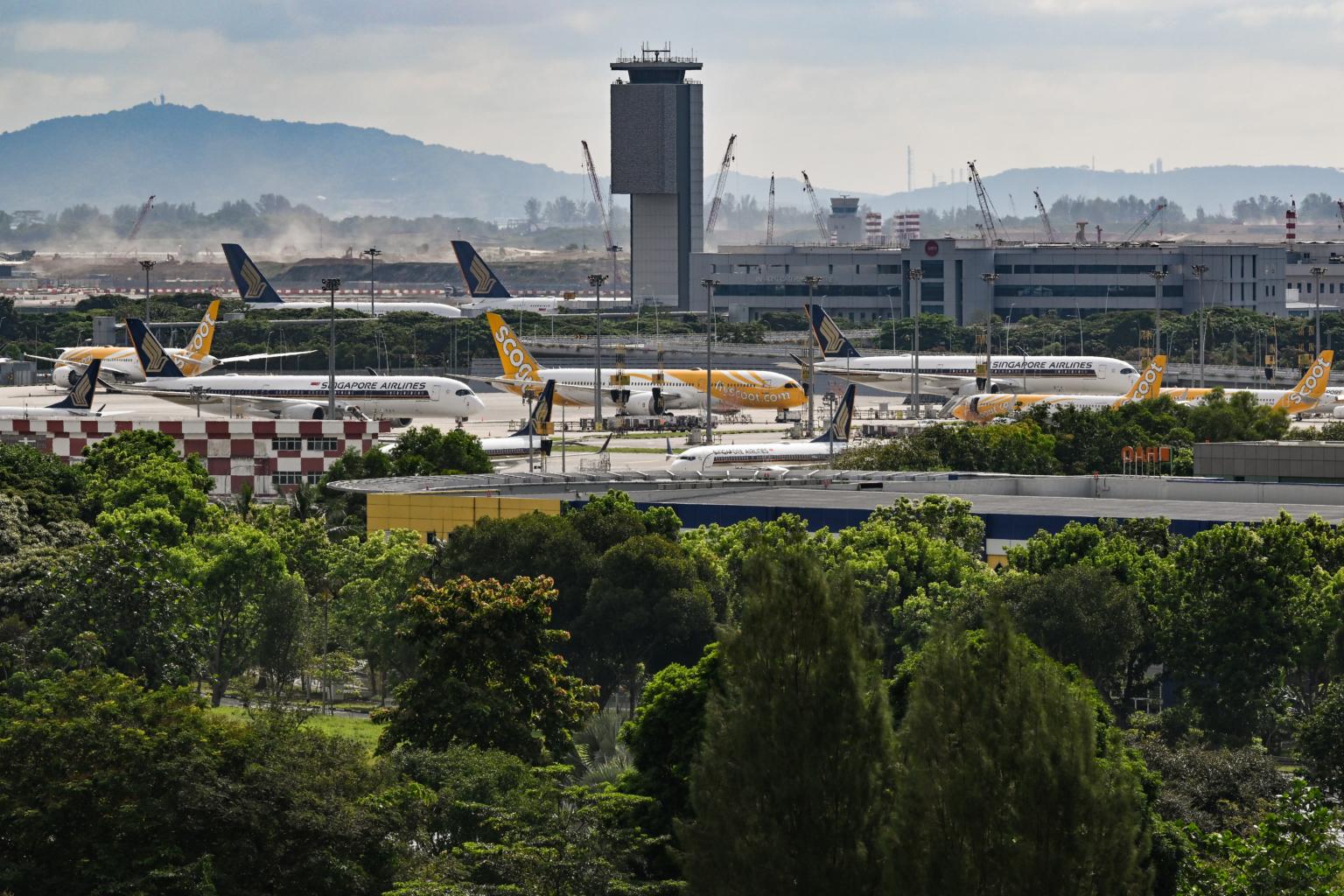National aviation safety plan to tackle risks that may have arisen from pandemic
Sign up now: Get ST's newsletters delivered to your inbox

The safety plan lists 50 actions that Singapore's aviation industry will take over the next three years.
ST PHOTO: LIM YAOHUI
Follow topic:
SINGAPORE - Singapore is taking steps to address aviation safety risks, both old and new, as international air travel ramps up following two years of pandemic-induced disruption.
Flight crew and air traffic controllers may have lost competency and aircraft may malfunction after prolonged inactivity, so to address these risks, the Civil Aviation Authority of Singapore (CAAS) on Friday (April 8) released its first ever National Aviation Safety Plan (NASP).
In it, CAAS flagged other pandemic-related issues, including a loss of familiarity with safety processes, a weakening of safety culture, and a loss of safety expertise due to cost-cutting.
These were identified based on information from regional and global sources, and in the context of Singapore's own operating environment, it said.
The safety plan lists 50 actions that Singapore's aviation industry will take over the next three years, focusing on five areas - operational safety; policies and rules; safety management; data and digitalisation; and regional and global aviation safety.
Some examples include reviewing flight crew reactivation and induction training, increasing the frequency of safety oversight activities on aircraft that have been taken out of cold storage, and enhancing runway safety at Changi and Seletar airports.
There are also plans to modernise aviation safety rules by enacting new laws.
CAAS noted that Covid-19 gave rise to an unprecedented disruption of air operations, and brought on additional safety risks.
"While there have been no fatal accidents (here) in the past two decades, we must continue to upkeep safety and not take safety for granted," it said.
In the NASP, CAAS said there continues to be safety risks inherent to aviation operations that the sector must pay attention to, such as mid-air collisions or the loss of control of an aircraft mid-flight.
Systems component failures and ground occurrences resulting in damage are of particular relevance to Singapore, based on data collected from accident and investigation reports, safety inspections, past trends and industry engagement.
Ground occurrences are accidents that occur while a plane is on the ground, such as at the airport gate or on taxiways.
Measures are already in place to deal with these risks but more actions are being developed, such as the strengthening of safety management capabilities, CAAS said.
Changes to the operating environment and introduction of new technology may also lead to additional dangers, the authority warned.
For instance, major infrastructural improvements at Changi Airport, the rebuilding of the second runway and the construction of new taxiways may lead to a loss of familiarity and impact air operations and aerodrome safety.
While new technologies offer greater reliability by reducing human error, they can also introduce new risks, CAAS said. Hence, regulations and safety management systems will have to adapt, and there needs to be stronger competencies in assessing new digital tools and systems.
"We must address the potential impact of increasing reliance on automation systems," CAAS said. "In cases of emergencies or system failures, the pilots' manual flying skills are crucial in ensuring safe outcomes."
CAAS will work closely with the Transport Safety Investigation Bureau here and the aviation sector at large to implement the NASP.
The plan will be reviewed by CAAS every three years, or more frequently if needed.
It will also monitor the implementation of the action items listed.
CAAS director-general Han Kok Juan said: "As we emerge from the Covid-19 pandemic and ramp up operations, aviation safety is a non-negotiable and the top priority for the Singapore aviation sector."
The Ministry of Transport has said that it aims to restore passenger volumes at Changi Airport to at least 50 per cent of pre-pandemic levels this year.
In the first two months of 2022, 1.42 million passengers passed through Changi - 13 per cent of the level before the pandemic. In contrast, 68 million passenger movements were registered at Changi in 2019.
With the number of travellers passing through the airport expected to increase in the coming months, Terminal 2 will reopen in phases from this year after two years of upgrading.
Transport Minister S. Iswaran said last week that Terminal 4, which has also been closed since May 2020, can be reopened at relatively short notice as well.
Singapore Airlines Group, which comprises flag carrier SIA and its budget arm Scoot, said it closely monitors the condition of its fleet, regardless of whether the planes are operational, parked or recently returned to service.
It leverages health alerts and analytics for preventive and predictive maintenance, and this has been in place even before the pandemic, it told The Straits Times.
The company ensures pilot competency through simulator training and a greater use of e-learning resources.
In 2020, it implemented an Evidence-Based Training simulator programme to ensure all pilots meet required competency levels, regardless of flight hours.
As at end-March, 95 per cent of SIA Group’s pilots and 99 per cent of its cabin crew are back in the skies.
The publication of Singapore's NASP is part of a larger global aviation safety road map by the International Civil Aviation Organisation, which has been encouraging its 193 member states to develop similar national safety plans.
Other countries that have already done so include India, France and Australia.
Last month, Singapore also launched its first-ever safety charter for the aviation sector. To date, 80 organisations including major airlines, aircraft manufacturers, ground handlers and industry associations have signed on.
In response to the announcement by CAAS, ICAO said it welcomed Singapore’s proactive approach to safety management.
The organisation added it was grateful for CAAS’s active involvement in the development of the ICAO global aviation safety plan.

